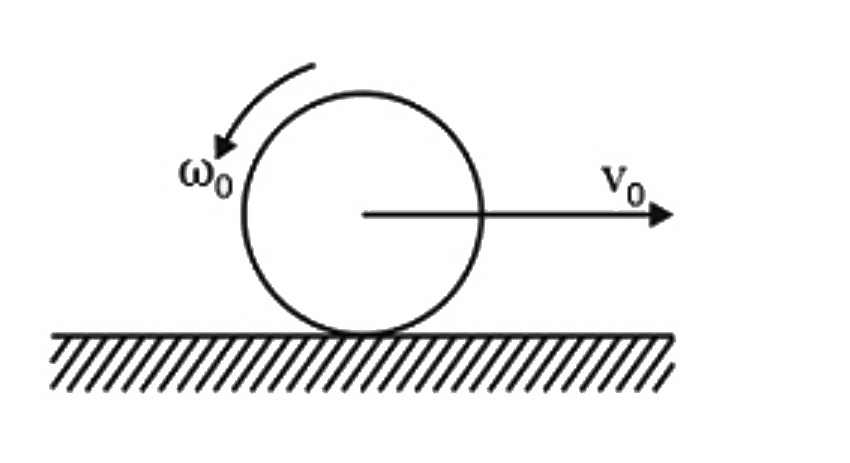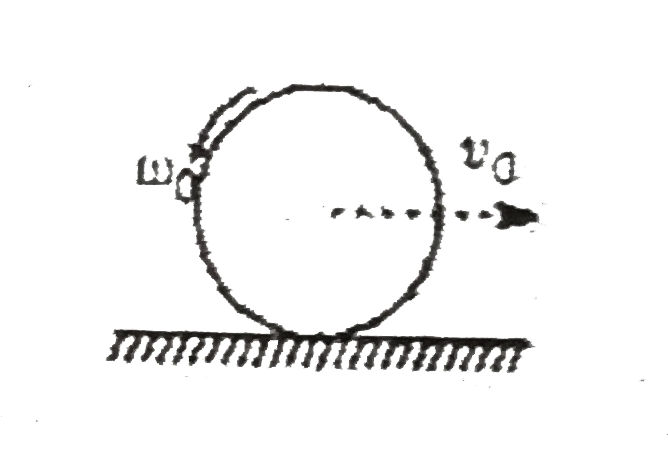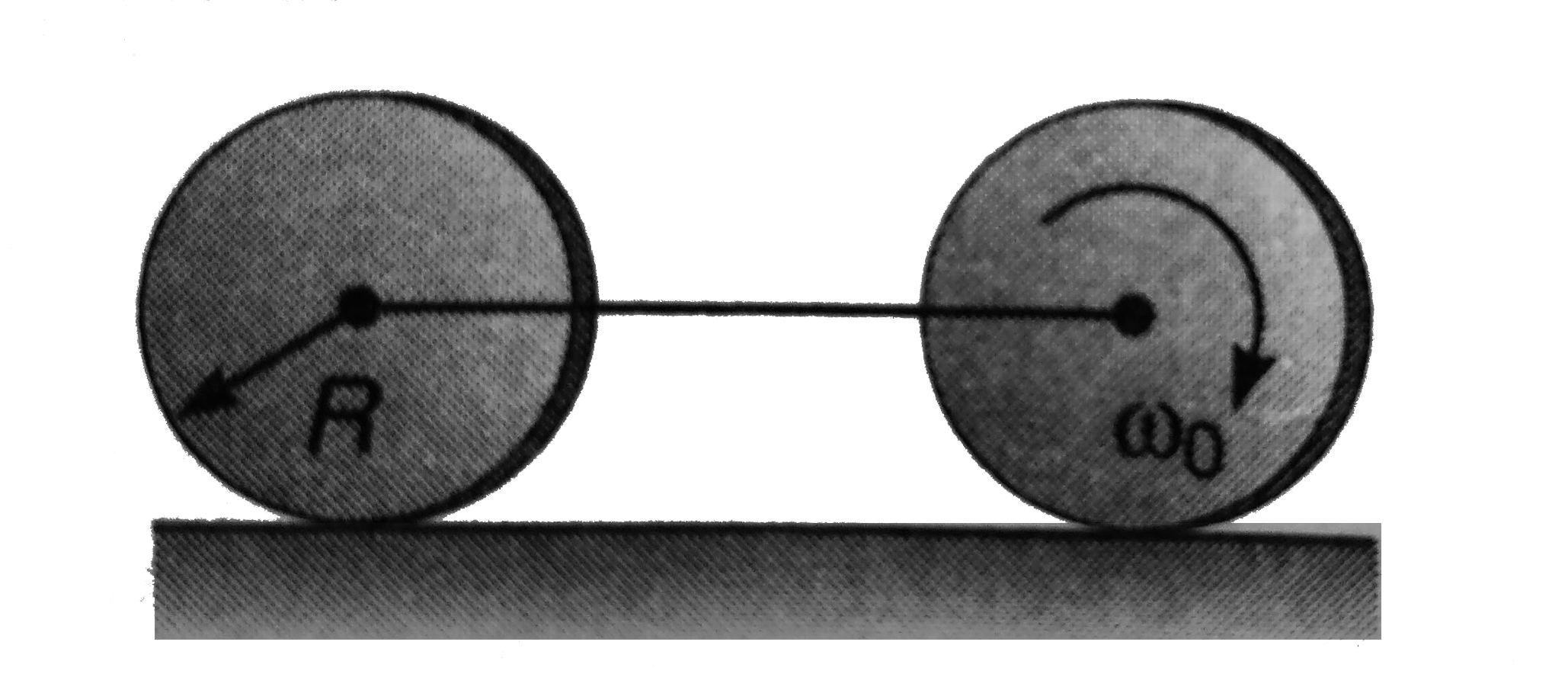A uniform disc of radius r0 lies on a smooth horizontal plane. A similar disc spinning with the angular velocity ω0 is carefully lowered onto the first disc. How soon do both discs spin with the same angular-velocity if the friction coefficient between them is equal to μ?
From the low of conservation of angular momentum.
Iω0=2Iω Here, I= moment of inertial of each disc relative to common rotation axis
∴ω=ω02= steady state angular velocity
the angular velocity of each disc varies due to the torque τ of the friction forces to calculate τ let us take an elementary ring with radii r and r+dr. The torque of the friction forces acting on the given ring is equal to

dtau= (friction force) (r⊥)=[μ(dm)g](r)
=μ(mgπr20)(2πrdr)r
=(2μmgr20)r2dr
where m is the mass of each disc. Integrating this with respect to r between 0 and r0, we get
τ=23μmgr0= constant
α=τI=(2μmgr0/3)(mr20/2)
=4μg3r0= constant
Now, angular speed of lower disc increases with this α from O to ω02 and α is constant
∴ω02=αt
or t=ω02α=3r0ω08μg
Topper's Solved these Questions
- ROTATIONAL MECHANICSBook:DC PANDEYChapter:ROTATIONAL MECHANICSExercise:Solved Example
Explore 1 Video
- ROTATIONAL MECHANICSBook:DC PANDEYChapter:ROTATIONAL MECHANICSExercise:Exercise 12.1
Explore 10 Videos
- ROTATIONAL MECHANICSBook:DC PANDEYChapter:ROTATIONAL MECHANICSExercise:Solved Examples
Explore 25 Videos
- ROTATIONBook:DC PANDEYChapter:ROTATIONExercise:(C) Chapter Exercises
Explore 39 Videos
- ROTATIONAL MOTIONBook:DC PANDEYChapter:ROTATIONAL MOTIONExercise:Integer Type Questions
Explore 17 Videos
Similar Questions
A uniform disc of radius R is spinned to the angular velocity ω and then carefully placed on a horizontal surface. How long will the disc be rotating on the surface if the friction coeffiecient is equal to k? The pressure exerted by the disc on the surface can be neglected as uniform.
View SolutionA uniform circular disc of radius r placed on a rough horizontal plane has initial velocity v0 and angular ω0 as shown. The disc comes to rest after moving some distance in the direction of motion. Then

View Solution
Knowledge Check
A uniform disc of mass M and radius R is rotating in a horizontal plane about an axis perpendicular to its plane with an angular velocity ω. Another disc of mass M/3 and radius R/2 is placed gently on the first disc coaxial. Then final angular velocity of the system is
A12ω/13B13ω/12C3ω/4D11ω/12A uniform circular disc of radius r . 1placed on a rough horizontal plane has initial velocity v0 and an angular velocity ω0 as shown. The disc comes to rest after moving some distance in the direction of motion. Then
 Athe friction force acts in the backwards directionBthe point of contact of disc with ground has zero velocityCv0 must be equal to rω02 in magnitudeDv0 must be equal to 2rω0 in magnitude
Athe friction force acts in the backwards directionBthe point of contact of disc with ground has zero velocityCv0 must be equal to rω02 in magnitudeDv0 must be equal to 2rω0 in magnitudeA uniform circular disc of radius r is placed on a rough horizontal surface and given a linear velocity v0 and angular velocity ω0 as shown. The disc comes to rest after moving some distance to the right. It follows that
 A3v0=2ω0rB2v0=ω0rCv0=ω0rD2v0=3ω0r
A3v0=2ω0rB2v0=ω0rCv0=ω0rD2v0=3ω0r
A uniform disc of radius R rolls perfectly over two horizontal plank A and B moving with velocities v and 2v, respectively. Find the

a. velocity of CM of the disc.
b. angular velocity of the disc.
View Solution
The assembly of two discs as shown in figure is placed on a rough horizontal surface and the front disc is given an initial angular velocity ω0. Determine the final linear and angular velocity when both the discs start rolling. it is given that friction is sufficient to sustain rolling the rear wheel from the starting of motion.
View SolutionA uniform disc of mass m and radius R I rotated about an axis passing through its centre and perpendicular to its plane with an angular velocity ω. It is placed on a rough horizontal plane with the axis of the disc keeping vertical. Coefficnet of friction between te disc and the surface is μ, find
(a). The time when disc stops rotating
(b). The angle rotated by the disc before stopping.
View SolutionA uniform disc of mass M and radius R is rotating about a horizontal axis passing through its centre with angular velocity ω . A piece of mass m breaks from the disc and flies off vertically upwards. The angular speed of the disc will be
View SolutionA heavy disc is rotating with uniform angular velocity ω about its own axis. A piece of wax sticks to it. The angular velocity of the disc will
View Solution

